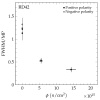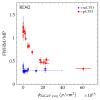A Study of the Radiation Tolerance of CVD Diamond to 70 MeV Protons, Fast Neutrons and 200 MeV Pions
- PMID: 33233598
- PMCID: PMC7699799
- DOI: 10.3390/s20226648
A Study of the Radiation Tolerance of CVD Diamond to 70 MeV Protons, Fast Neutrons and 200 MeV Pions
Abstract
We measured the radiation tolerance of commercially available diamonds grown by the Chemical Vapor Deposition process by measuring the charge created by a 120 GeV hadron beam in a 50 μm pitch strip detector fabricated on each diamond sample before and after irradiation. We irradiated one group of samples with 70 MeV protons, a second group of samples with fast reactor neutrons (defined as energy greater than 0.1 MeV), and a third group of samples with 200 MeV pions, in steps, to (8.8±0.9) × 1015 protons/cm2, (1.43±0.14) × 1016 neutrons/cm2, and (6.5±1.4) × 1014 pions/cm2, respectively. By observing the charge induced due to the separation of electron-hole pairs created by the passage of the hadron beam through each sample, on an event-by-event basis, as a function of irradiation fluence, we conclude all datasets can be described by a first-order damage equation and independently calculate the damage constant for 70 MeV protons, fast reactor neutrons, and 200 MeV pions. We find the damage constant for diamond irradiated with 70 MeV protons to be 1.62±0.07(stat)±0.16(syst)× 10-18 cm2/(p μm), the damage constant for diamond irradiated with fast reactor neutrons to be 2.65±0.13(stat)±0.18(syst)× 10-18 cm2/(n μm), and the damage constant for diamond irradiated with 200 MeV pions to be 2.0±0.2(stat)±0.5(syst)× 10-18 cm2/(π μm). The damage constants from this measurement were analyzed together with our previously published 24 GeV proton irradiation and 800 MeV proton irradiation damage constant data to derive the first comprehensive set of relative damage constants for Chemical Vapor Deposition diamond. We find 70 MeV protons are 2.60 ± 0.29 times more damaging than 24 GeV protons, fast reactor neutrons are 4.3 ± 0.4 times more damaging than 24 GeV protons, and 200 MeV pions are 3.2 ± 0.8 more damaging than 24 GeV protons. We also observe the measured data can be described by a universal damage curve for all proton, neutron, and pion irradiations we performed of Chemical Vapor Deposition diamond. Finally, we confirm the spatial uniformity of the collected charge increases with fluence for polycrystalline Chemical Vapor Deposition diamond, and this effect can also be described by a universal curve.
Keywords: Chemical Vapor Deposition; charge collection distance; mean drift path; polycrystalline diamond; radiation damage constant; radiation tolerance; schubweg; single-crystalline diamond.
Conflict of interest statement
The authors declare no conflict of interest.
Figures

















References
-
- CERN The European Organization for Nuclear Research, CH-1211, Genève 23, Switzerland. [(accessed on 11 November 2020)]; Available online: https://home.cern/
-
- Apollinari G., Brüning O., Nakamoto T., Lucio R. High-Luminosity Large Hadron Collider (HL-LHC): Preliminary Design Report, Chapter 1: High-Luminosity Large Hadron Collider HL-LHC. CERN; Geneva, Switzerland: 2015. CERN Yellow Reports: Monographs, CERN-2015-005. - DOI
-
- Apollinari G., Béjar A.I., Brüning O., Fessia P., Lamont M., Rossi L., Tavian L. High-Luminosity Large Hadron Collider (HL-LHC): Technical Design Report V.0.1. CERN; Geneva, Switzerland: 2017. CERN Yellow Reports: Monographs, Volume 4/2017 CERN-2017-007-M. - DOI
-
- Bäni L., Alexopoulos A., Artuso M., Bachmair F., Bartosik M., Beck H., Bellini V., Belyaev V., Bentele B., Bes A., et al. ((On behalf of the RD42 Collaboration)). A study of the radiation tolerance of poly-crystalline and single-crystalline CVD diamond to 800 MeV and 24 GeV protons. J. Phys. D Appl. Phys. 2019;52:465103. doi: 10.1088/1361-6463/ab37c6. - DOI
-
- The Samples Used in this Study Were Electronic Grade CVD Diamond Purchased from Element Six Technologies, Global Innovation Centre, Fermi Ave., Harwell, OX11 0QR, United Kingdom and II-VI Incorporated, 375 Saxonburg Blvd., Saxonburg, PA 16056-9499, USA. [(accessed on 11 November 2020)]; Available online: http://www.iiviinfrared.com.
Grants and funding
LinkOut - more resources
Full Text Sources
Research Materials
Miscellaneous

